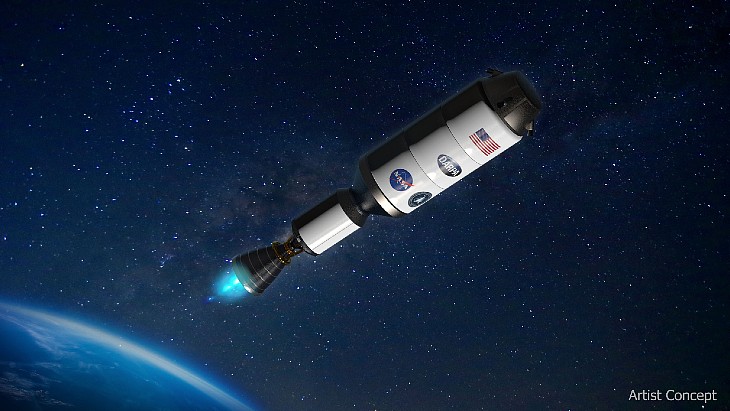The two organisations announced on Tuesday they will partner on the Demonstration Rocket for Agile Cislunar Operations (DRACO) programme, with the agreement aimed at speeding up development efforts.
NASA administrator Bill Nelson said the aim was to develop and demonstrate advanced nuclear thermal propulsion technology as soon as 2027, adding: "With the help of this new technology, astronauts could journey to and from deep space faster than ever - a major capability to prepare for crewed missions to Mars."
It is more than 50 years since the last nuclear thermal rocket engine tests were conducted by the USA. In a nuclear thermal rocket engine a fission reactor generates extremely high temperatures and the engine then, explains NASA, "transfers the heat to a liquid propellant which is expanded and exhausted through a nozzle to propel the spacecraft", in a similar way to a conventional chemical rocket engine.
DARPA says that DRACO’s proposed solid core nuclear thermal rocket temperatures could reach almost 5000 degrees fahrenheit, requiring use of advanced materials. It will use high-assay low-enriched uranium (HALEU) fuel, rather than highly-enriched uranium, "to have fewer logistical hurdles on its ambitious timeframe". The plan is to engineer the system so the engine's fission reaction will only turn on once it is in space. The goal is to test the nuclear thermal rocket engine enabled spacecraft in Earth orbit during 2027.
Using a nuclear thermal rocket will reduce travel time, bringing a range of potential benefits ranging from sending cargo to any future lunar base, human missions to Mars and unmanned voyages further afield. DARPA says that the nuclear thermal rocket "offers a thrust-to-weight ration 10,000 times greater than electric propulsion" and "with two to five times greater efficiency than in-space chemical propulsion".
In addition to cutting down the transit time, there will be increased science payload capacity and higher power for instrumentation and communication.
Stefanie Tompkins, director, DARPA said: "DARPA and NASA have a long history of fruitful collaboration in advancing technologies for our respective goals, from the Saturn V rocket that took humans to the Moon for the first time to robotic servicing and refueling of satellites. The space domain is critical to modern commerce, scientific discovery, and national security. The ability to accomplish leap-ahead advances in space technology through the DRACO nuclear thermal rocket programme will be essential for more efficiently and quickly transporting material to the Moon and eventually, people to Mars."
The agreement details that NASA’s Space Technology Mission Directorate will lead technical development of the nuclear thermal engine, which will be integrated with DARPA’s experimental spacecraft. According to the announcement DARPA "will lead the overall programme including rocket systems integration and procurement, approvals, scheduling, and security, cover safety and liability, and ensure overall assembly and integration of the engine with the spacecraft. Over the course of the development, NASA and DARPA will collaborate on assembly of the engine before the in-space demonstration as early as 2027".
NASA and the US Department of Energy (DOE) have a separate project on-going to advance higher temperature fission fuels and reactor designs as part of a nuclear thermal propulsion engine which will not be used in this project. NASA and DOE have also worked together with commercial partners on developing nuclear power plants concepts that could be used on the Moon, and potentially, Mars.





_47120.jpg)

_23621.jpg)






